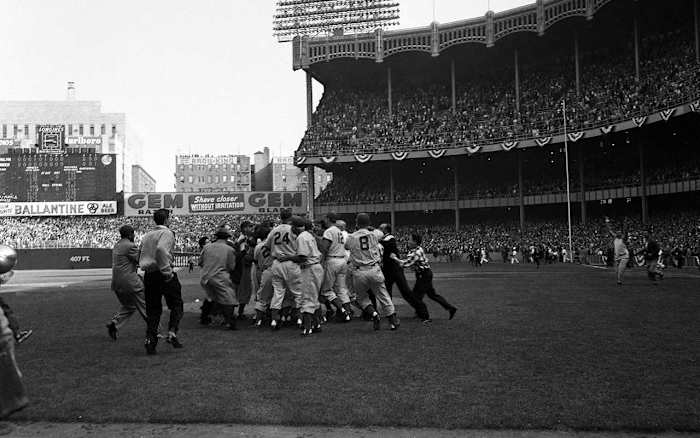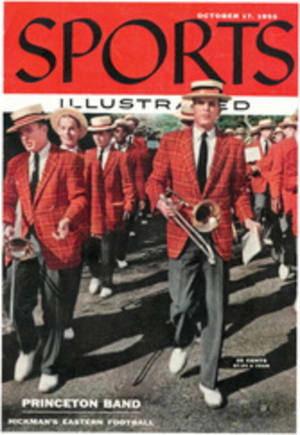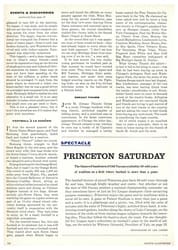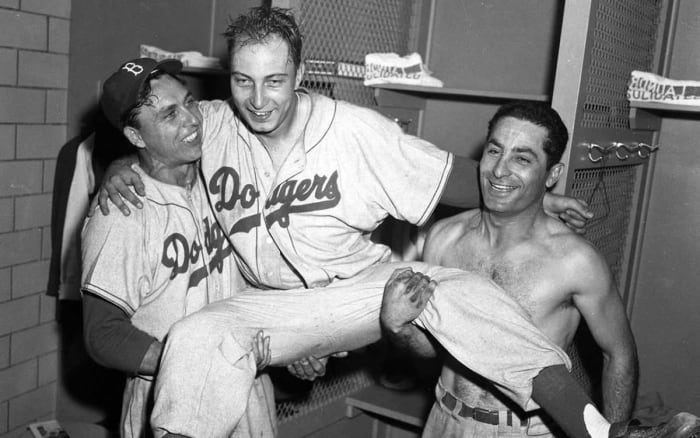When Brooklyn Won
You have read of dancing in the streets at times of great joy? It is an apt phrase, but one more often figurative than literal. Yet on the night of October 4 in the year 1955, there really was dancing in the streets of Brooklyn, and weeping for pure joy, too. For that was the day the Dodgers at long, long last brought the baseball championship of the world home to Flatbush. Hundreds crammed into the ancient Hotel Bossert on Montague Street to help the Dodgers celebrate. Thousands more milled around outside, cheering, yelling, dancing.
In the far-off Caribbean, where the Dodgers, first major league team to break the color line in baseball, were immensely popular, 5,000 people paraded for four hours through the city of St. Thomas in the Virgin Islands, carrying banners that said "At last—Brooklyn wins" and "Snider, Duke of Bedford Avenue." In Ciudad Trujillo in the Dominican Republic, where the Dodgers had trained in 1948, an enterprising reporter wrote that a brand-new baby had been named Podres Garcia, after Johnny Podres, Brooklyn pitching hero of the Series.
Oh, it was a day to burn into your memory. And it was a game to remember, too. You must realize that whenever baseball men gather for small talk, to cut up old touches and freshen yellowed memories, they always drag out ball games long since played and run them through the projector of reminiscence. They recall a fielding play from this one, the way a man ran bases in that one, the things a hitter did in still another.
Occasionally, they will recall the contest itself, the whole game, the entity, the things that went before it and the things that came after, and then it is a really special memory, because of all the thousands on thousands of ball games played since the beginning of time—which in baseball legend is reckoned as 1839—only a handful, perhaps a dozen or two, are accorded this honor.
Thus, when a game barely finished is at once added to this select few—instantly caught in memory, so to speak, like an insect perfectly preserved for all time in a piece of clear amber—it is a very rare game indeed.
Such was the seventh and deciding game of the first World Series ever won by the Brooklyn Dodgers. First of all, it was undeniably historic. Then, because it was the culmination of a tremendously spirited comeback by the Brooklyns who, two down after the first two games, won four of the next five to win the Series, it was splendidly dramatic. And, finally, since it marked the end of the curious domination the New York Yankees had held for so long over the Dodgers, and destroyed the latest myth of Yankee invincibility, it was properly epic.
The pitchers were lean, dark, hawk-faced Tommy Byrne, who had crowned his comeback from the minor leagues with a victory over the Dodgers in the second game; and blond, blue-eyed youthful Johnny Podres, whose masterful handling of New York in the third game had stopped a Yankee runaway.
The Dodgers, in the first three innings, managed to get just two men on base against Byrne, both by walks, and neither went past first. But the inexorable Yankees, in the last half of the third inning, moved to demolish Podres. With two out Rizzuto walked on four straight bad pitches, and Martin singled. The awkward, dangerous McDougald fenced with Podres, ball by strike, until the count reached the classic three-and-two and John Podres reached the near edge of destruction. As Podres and McDougald fought, the menacing Yogi Berra, waiting to bat next, slowly waved two bats back and forth, seeming bemused, watching Podres like a patient, hungry cat.
Podres, to his credit, put the three-and-two pitch over the plate, but McDougald tapped a heartbreaking little grounder toward third base that seemed sure to be a safe hit to load the bases, since the third baseman, Hoak, playing back, had no chance to get in 'to it in time. Rizzuto, hurrying down from second, slid into third...and incredibly the slowly moving ball bounced off his leg and ricocheted past the base. No one for a moment knew just what happened, but then it was clear: a batted ball had struck the base runner. Rizzuto was out. The inning was over. The Dodgers were safe. Berra had to put down his bats.
The Dodgers scored the first run of the game in the fourth inning when Gil Hodges, batting with two men out and a runner on third, doggedly stood up to Byrne, even after the left-hander had sent two good called strikes past him, and then broke the pitcher's heart by hitting a single into left field for the run. They scored again in the sixth, adding what is aptly called the insurance run. This is the one extra run that limits the enemy's maneuvering, alters his strategy and generally provides the team that has it with a pleasant added measure of comfort and confidence in times of stress like, say, the last three innings of the final game of a seven-game World Series.
Comfort, confidence or whatever, everything went well with the Brooklyns. For instance, Manager Walter Alston pressed his luck and tried for even more runs by inserting a pinch hitter for Don Zimmer, his second baseman. The pinch hitter failed, but this was Brooklyn's day, you see, and the move paid off anyway. Gilliam, who had been playing left field, moved to second to replace Zimmer, and little Sandy Amoros, a fleet-footed Cuban, took Gilliam's place in left. And, almost immediately, in the bottom of that sixth inning, came the fantastic play illustrated in detail above, the play that brought the Yankees crashing down to earth. And Amoros was the key to it. Gilliam, wise men opined, would never have made the play.
The last three innings were brilliant with tension. Now, at last, it seemed that it could be done: the Yankees could lose; and more, the Dodgers could win.
The seventh inning belonged to Pee Wee Reese, the captain of the team, the veteran shortstop who had played in five losing World Series and who wanted so much to win. He charged Skowron's grounder like a ferret, pounced on it and made the play. Cerv hit another grounder that Pee Wee, almost frantic with need, charged and handled. Howard singled but the injured Mickey Mantle, pinch-hitting, popped up behind third, and Reese, rushing under it, bounced with eagerness, waiting, bounced, bounced, grabbed the ball, and bounced again, lightly now, with the third out in his glove.
In the eighth the Yankees made a last, vain, thrashing grab for victory. Rizzuto singled. Crafty little Martin, two runs behind, tried to push a hit into right, but Furillo came fast and took it at his knees. McDougald rapped a base hit. Berra, the menace, gave Brooklyn pause, but he lifted a high fly to right. Two out now. The fierce Hank Bauer was at bat, and the Yankees were on the edge of the dugout. Podres threw a ball to Bauer, then a called strike. Bauer fouled a pitch back to the screen and took a second ball. Podres set himself and then threw violently, as hard as he could, with so much effort that he fell off the mound toward third base, staggering to keep his balance. The pitch split the plate. Bauer swung and missed, and the crowd roared, a full-throated shout of victory. The Dodgers jounced off the field.
The ninth was Podres' inning. His strength and speed were overpowering, and the anticipation of victory rode on every pitch. Skowron tapped back to the mound, and John, plucking the ball tardily from the netting of his glove, threw him out. Cerv raised an easy fly to Amoros. Howard, the last man, took a called strike (the crowd exploded with noise), a ball, swung and missed (another explosion), took a second ball high. He stepped out of the batter's box, and the crowd jeered impatiently. He stepped back in. He fouled a pitch back, fouled another. The Dodger infield moved restlessly, fidgeting. Podres threw again, a big fat, arrogant changeup that Howard swung at and topped on the ground, fittingly enough toward Reese. Pee Wee fielded it (commenting later that it seemed to take hours to pick up the ball), threw it to first to Hodges, and that was it. After a half century of waiting the Brooklyn Dodgers were champions of the world.
ILLUSTRATION
ROBERT
RIGER
THE SIGHT THAT CHILLED YANKEE HEARTS AND YANKEE BATS: JOHNNY PODRES
PITCHINGILLUSTRATIONROBERT RIGERDASCOLI
HODGES
GILLIAM
DICKEY
McDOUGALD
SUMMERS
BERRA
MARTIN
CARRIERI
HONOCHICK
BAUER
CAMPANELLA
PODRES
REESE
HOAK
CROSETTI
BALLANFANT
FLAHERTY
AMOROS
THE PLAY THAT MADE HISTORY
In the last half of the sixth inning of the seventh game, with the Dodgers leading 2-0, McDougald on first and Martin on second, no one out and Berra at bat with a count of one ball and no strikes, Podres threw a low, outside fast ball that Berra popped up high and far down the left-field line. Berra ran for first. McDougald, hoping to score the tying run if the ball fell safely, raced for second. Martin went halfway from second toward third and paused to see if the ball would be caught. First-Base Coach Dickey and Third-Base Coach Crosetti stood erect, watching the ball. Bauer, the next batter, knelt in the on-deck circle near Bat Boy Carrieri. Plate Umpire Honochick stepped to one side to follow flight of ball. First-Base Umpire Dascoli waited several feet past first. Second-Base Umpire Summers turned to watch base. Third-Base Umpire Ballanfant trotted a few steps toward the outfield. Left-Field Umpire Flaherty moved quickly toward the left-field corner. Podres ran off the mound to back up third base. Catcher Campanella stood near home plate. First Baseman Hodges and Second Baseman Gilliam, playing deep for Berra, ran in to cover their bases. Shortstop Reese ran over to the edge of the outfield grass near third to be in position to relay a throw on to third or home. Third Baseman Hoak waited at the base. Left Fielder Amoros, who had been playing well into left-center field (white circle) for left-handed Berra, sprinted almost 150 feet (dotted line) across the outfield grass toward the point where the ball was dropping into the left-field corner. At the last moment he braked himself on the heel of his left foot and stuck out his right, or gloved, hand to catch the ball. This was the first out of the inning. McDougald, by now a step past second, turned hurriedly and fled back toward first, but Reese, waiting for the throw from the outfield, glimpsed him from the corner of his eye. In the outfield Amoros, after catching the ball, spun quickly around toward third and rifled it (solid line) in to Reese. Reese took the throw head high on his glove side and without hesitating wheeled and blazed the ball (solid line) across the infield to Hodges at first base. Hodges caught the perfect throw letter-high on a long stretch just in time to double-up the desperately sliding McDougald for the second out. Bauer then came to bat and grounded to Reese for the third out of the historic inning.



